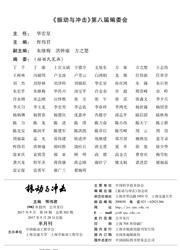

 中文摘要:
中文摘要:
针对转子偏心引起的密封流体激振问题,设计了一种新型偏心自适应调节密封结构。该结构可自适应地减小转子偏心量,抑制密封流体激振。对其抑振机理进行探究,得出当偏心自调结构的固有频率和转子密封系统的激励频率一致时,其抑振效果最好;随着两者差值增大,其抑振效果变弱。以水作为密封介质,测量了不同弹簧刚度下偏心自调结构的固有频率,并改变转子转频,对其抑振规律进行实验研究。结果表明该结构固有频率随弹簧刚度增大而增大,但与激励频率差别较大,振动降幅只在10%~20%之间。将偏心自调结构浸于水,测量其固有频率,对其抑振规律进行实验研究。结果表明浸在水中时该结构固有频率值依然随弹簧刚度增大而增大,但比在空气中时减小了约40%,更加接近激励频率,抑制效果显著,振动降幅最大可达41.27%。
 英文摘要:
英文摘要:
Aiming at the seal fluid excitation problem caused by rotor eccentricity, a new eccentricity self-adjusting seal structure which can decrease rotor eccentricity was designed and its vibration suppression mechanism was explored. Theory concludes that the vibration suppression effect is the best only when the designed structure natural frequency is consistent with the rotor-seal exciting frequency. Otherwise, the effect becomes weaker. With using water as the sealing media, the designed structure natural frequencies under different spring stiffness were measured specifically. With changing rotating frequency, the structure vibration suppression laws were experimentally researched. Results show that the structure frequencies increase with the increased spring stiffness but are much higher than the rotor-seal exciting frequency. The vibration amplitude decrease ratios are not notable and only maintain between 10%~20%. Then the eccentricity structure was put in the water and its frequency in water was measured. Similarly, its vibration suppression laws in water were experimentally researched. Results demonstrate that the structure in water frequencies still increase with the increased spring stiffness but are lower about 40% than in the air. So structure frequencies in the water are closer to the exciting frequency and the vibration suppression effects in this condition are more obvious. Finally, the maximum vibration amplitude decrease ratio reaches to 41.27%.
 同期刊论文项目
同期刊论文项目
 同项目期刊论文
同项目期刊论文
 期刊信息
期刊信息
